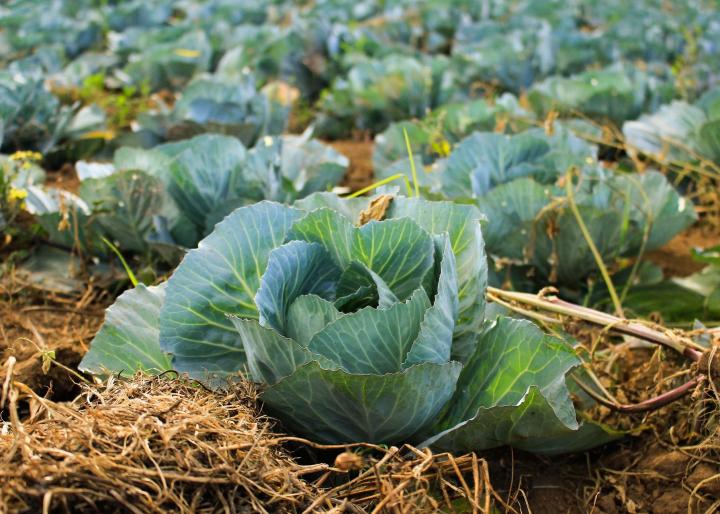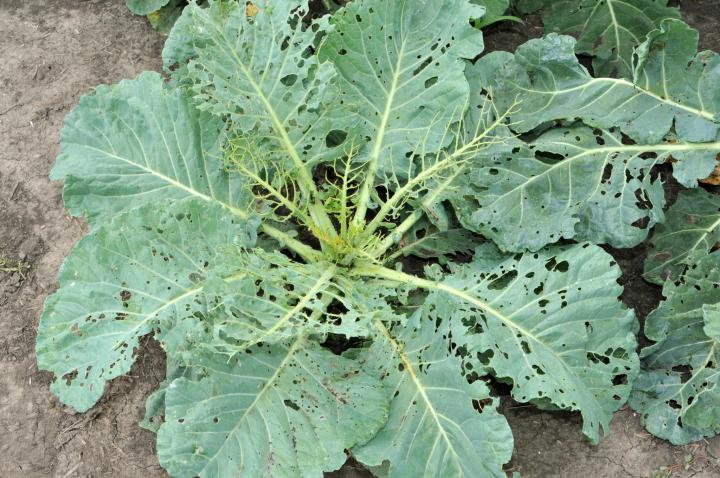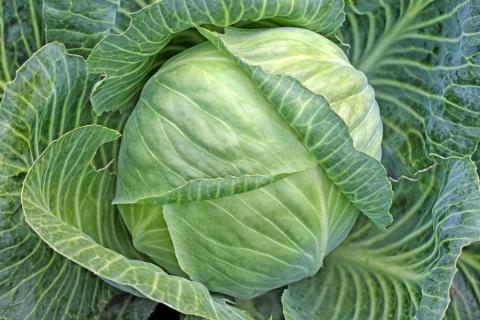Cabbage is a cool-season vegetable suited to both spring and fall. See our Cabbage Growing Guide with instructions on how to plant and grow this hardy, leafy vegetable—which is packed with vitamins!
About Cabbage
Mark Twain once said, “Cauliflower is nothing but cabbage with a college education.” In fact, cabbage is no longer viewed so poorly. We now know that this hardy vegetable is antioxidant- and nutrient-rich, and a great addition to any garden! See 5 reasons to eat cabbage.
That said, note that cabbage can be challenging to grow for the beginner gardener if you don’t have the right conditions; it only likes cool temperatures and it can be a magnet for some types of garden pests. Rotating the cabbage crop every few years avoids buildup of soilborne diseases.
Follow our guide to plant a successful crop in the spring or fall—and we’ll help you provide the diligent care that cabbage needs.
When to Plant Cabbage
- If starting seeds indoors, sow 1/4 inch deep 6 to 8 weeks before the last spring frost. Consult our Planting Calendar for suggested dates.
- For a fall harvest, direct sow seeds outdoors (or plant transplants) in mid- to late summer. If your area is particularly hot and dry, hold off on planting until late summer. Make sure that the young plants don’t dry out in the summer sun’s heat!
Choosing and Preparing a Planting Site
- Cabbage is a heavy feeder; it quickly depletes the soil of required nutrients.
- Prepare the soil in advance by mixing in aged manure and/or compost.
- Soil should be well-draining: roots that stand in water cause heads to split or rot.
How to Plant Cabbage
- Before planting the seedlings outdoors, harden off the plants over the course of a week.
- Transplant small plants outdoors on a cloudy afternoon 2 to 3 weeks before the last spring frost date.
- Plant seedlings 12 to 24 inches apart in rows, depending on the size of head desired. The closer you plant, the smaller the cabbage heads.
Check out this video to learn how to plant cabbages:
How to Grow Cabbages
- When seedlings reach about 5 inches tall, thin to leave the desired space between them. If you wish, transplant the thinned seedlings elsewhere.
- Mulch thickly around the area to retain moisture and regulate soil temperature.
- Water 2 inches per square foot per week.
- The optimum soil temperature for growth is 60 to 65° F. Young plants exposed to temperatures below 45°F for a period of time may bolt or form loose heads. Cover plants if cold weather is expected.
- Fertilize 2 weeks after transplanting with a balanced (10-10-10) fertilizer.
- Three weeks later, add a nitrogen-rich fertilizer; cabbage needs nitrogen in the early stages.
- Practice crop rotation with cabbages to avoid a buildup of soil-borne diseases.

Some old folklore tells us: Scatter elder leaves over your cabbage to keep the bugs away.
| Pest/Disease | Type | Symptoms | Control/Prevention |
|---|---|---|---|
| Aphids | Insect | Misshapen/yellow leaves; distorted flowers/fruit; sticky “honeydew” (excrement); sooty, black mold | Grow companion plants; knock off with water spray; apply insecticidal soap; put banana or orange peels around plants; wipe leaves with a 1 to 2 percent solution of dish soap (no additives) and water every 2 to 3 days for 2 weeks; add native plants to invite beneficial insects |
| Black rot | Fungus | Yellow, V-shape areas on leaf edges that brown and progress toward leaf center; leaves eventually collapse; stem cross sections reveal blackened veins |
Destroy infected plants; choose resistant varieties; provide good drainage; remove plant debris; rotate crops |
| Cabbage loopers | Insect | Large, ragged holes in leaves from larval feeding; defoliation; stunted or bored heads; excrement | Handpick; add native plants to invite beneficial insects; spray larvae with insecticidal soap or Bt; use row covers; remove plant debris |
| Cabbage root maggots | Insect | Wilted/stunted plants; off-color leaves; larvae feeding on roots | Use collars around seedling stems; monitor adults with yellow sticky traps; use row covers; destroy crop residue; till soil in fall; rotate crops |
| Cabbageworms | Insect | Leaves have large, ragged holes or are skeletonized; heads bored; dark green excrement; yellowish eggs laid singly on leaf undersides | Handpick; use row covers; add native plants to invite beneficial insects; grow companion plants (especially thyme); spray Bacillus thuringiensis (Bt) |
| Clubroot | Fungus | Wilted/stunted plants; yellow leaves; roots appear swollen/distorted | Destroy infected plants; solarize soil; maintain soil pH of around 7.2; disinfect tools; rotate crops |
| Downy mildew | Fungus | Yellow, angular spots on upper leaf surfaces that turn brown; white/purple/gray cottony growth on leaf undersides only; distorted leaves or corn tassels; defoliation | Remove plant debris; choose resistant varieties; ensure good air circulation; avoid overhead watering |
| Flea beetles | Insect | Numerous tiny holes in leaves | Use row covers; mulch heavily; add native plants to invite beneficial insects |
| Slugs/snails | Insect | Irregular holes in leaves/flowers; gouged fruit; slimy secretion on plants/soil; seedlings “disappear” | Handpick; avoid thick bark mulch; use copper plant collars; avoid overhead watering; lay boards on soil in evening, and in morning dispose of “hiding” pests in hot, soapy water; drown in deep container filled with 1/2 inch of beer, or sugar water and yeast, and sunk so that top edge is slightly above ground; apply 1-inch-wide strip of food-grade diatomaceous earth as barrier |
| Stinkbugs | Insect | Yellow/white blotches on leaves; scarred, dimpled, or distorted fruit/pods; shriveled seeds; eggs, often keg-shape, in clusters on leaf undersides | Destroy crop residue; handpick (bugs emit odor, wear gloves); destroy eggs; spray nymphs with insecticidal soap; use row covers; weed; till soil in fall |
| Thrips | Insect | Leaves, especially in folds near base, have white patches or silver streaks; brown leaf tips; blistering/bronzing on cabbage leaves; brown streaks on cauliflower curds; bulbs/ heads distorted or stunted; curling or scarring | Remove plant debris; choose resistant varieties; add native plants to invite beneficial insects; use row covers; use straw mulch; monitor adults with yellow or white sticky traps; use sprinklers or other overhead watering |
| White mold | Fungus | Pale gray, “water-soaked” areas on stems, leaves, and other plant parts that enlarge and develop white, cottony growth, later with black particles; bleached areas; crowns/ fruit rot; plants wilt/collapse | Destroy infected plants; ensure good air circulation; water in morning; weed; destroy crop residue; rotating crops on 5-year or longer cycle may help |

Cabbages comes in a range of sizes, shapes, and colors.
- For an early harvest, try ‘Primo’ or ‘Stonehead.’
- Quick-maturing ‘Golden Acre’ and ‘Quick Start’ yield 3-pound heads.
- For Savoy types, try ‘Alcosa’, an early variety, or ‘Wirosa’, a late variety that overwinters as-is in southern gardens but needs protection in the North.
- ‘Early Jersey Wakefield’ resists splitting. It’s an heirloom, slightly pointed, and 2- to 3-pound heads.
- ‘Gonzales’ produces softball-sized heads, making it good for small gardens.
- Disease-resistant varieties include ‘Blue Vantage’ and ‘Cheers’.
- If you are planting for a fall harvest, try red or Chinese cabbage. Good varieties include ‘Integro’ and ‘Ruby Perfection’ (reds) and ‘Li Ren Choy’ (baby bok choy).
How to Harvest Cabbages
- Harvest when heads reach desired size and are firm. Mature heads left on the stem may split. Days to maturity is around 70 days for most green cabbage varieties and most produce 1- to 3-pound heads.
- To harvest, cut each cabbage head at its base with a sharp knife. Remove any yellow leaves (retain loose green leaves; they provide protection in storage) and immediately bring the head indoors or place it in shade. Alternatively, pull up the plant (roots and all) and hang it in a moist cellar that reaches near-freezing temperatures.
- To get two crops, cut the cabbage head out of the plant, leaving the outer leaves and root in the garden. The plant will send up new heads; pinch off those until only four or so smaller heads remain. Harvest when tennis ball-size (perfect for salads!).
- After harvesting, remove the entire stem and root system from the soil to prevent disease. Only compost healthy plants; destroy any with maggot infestation.
How to Store Cabbages
- Cabbage can be stored in the refrigerator for up to two weeks, wrapped lightly in plastic. Make sure it is dry before storing. In proper root cellar conditions, cabbage will keep for up to 3 months. See our article on root cellars.
- Follow this old-time technique to get the most out of your cabbage crop:
- In the fall, harvest the entire cabbage plant—stems, head, and roots—enjoying the head as usual and storing the roots in a root cellar through winter.
- As soon as the ground has thawed in spring, plant the roots outdoors.
- Soon, fresh sprouts will form, which can be eaten alone or added to soups, salads, or a dish of your choice.
- These replanted cabbages won’t produce full heads, but they should go to seed by the end of summer, providing next year’s round of cabbage seeds!
- Note: This can also be done indoors on a windowsill in mid- to late winter; keep roots damp and sprouts should form.
- Traditionally, cabbage seeds were planted on St. Patrick’s Day in northern zones. Old-time farmers believed that to make them grow well, you needed to plant them while wearing your nightclothes!
- Plant near beans and cucumbers, not near broccoli, cauliflower, strawberries, or tomatoes. Check out our chart of plant companions for an expanded list of friends and foes.
- A 127-pound cabbage won first prize at the Alaska State Fair in 2009.
Cabbage: A familiar kitchen-garden vegetable about as large and wise as a man’s head.
—Abrose Bierce (1842–c.1914)
If boiling cabbage, drop walnuts (shell on) into the water; they will absorb the cabbage’s unpleasant odor.




